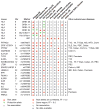Review: Genetics and the Classification of Arthritis in Adults and Children
- PMID: 29024575
- PMCID: PMC5805142
- DOI: 10.1002/art.40350
Review: Genetics and the Classification of Arthritis in Adults and Children
Abstract
Current classification of primary inflammatory arthritis begins from the assumption that adults and children are different. No form of juvenile idiopathic arthritis bears the same name as an adult arthritis, a nomenclature gap with implications for both clinical care and research. Recent genetic data have raised questions regarding this adult/pediatric divide, revealing instead broad patterns that span the age spectrum. Combining these genetic patterns with demographic and clinical data, we propose that inflammatory arthritis can be segregated into 4 main clusters, largely irrespective of pediatric or adult onset: seropositive, seronegative (likely including a distinct group that usually begins in early childhood), spondyloarthritis, and systemic. Each of these broad clusters is internally heterogeneous, highlighting the need for further study to resolve etiologically discrete entities. Eliminating divisions based on arbitrary age cutoffs will enhance opportunities for collaboration between adult and pediatric rheumatologists, thereby helping to promote the understanding and treatment of arthritis.
© 2017, American College of Rheumatology.
Conflict of interest statement
The authors disclose no conflicts of interest directly relevant to this work. PAN is the recipient of investigator-initiated research grants from AbbVie, Novartis and Sobi; consulting fees from Casebia, Novartis, Pfizer, Sobi, and UCB; salary support from the Childhood Arthritis & Rheumatology Research Alliance; and royalties from UpToDate, Inc. and the American Academy of Pediatrics. SR and ST report no disclosures.
Figures


References
-
- Petty RE, Southwood TR, Manners P, Baum J, Glass DN, Goldenberg J, et al. International League of Associations for Rheumatology classification of juvenile idiopathic arthritis: second revision, Edmonton, 2001. The Journal of rheumatology. 2004;31(2):390–2. - PubMed
-
- Garrod AE. A treatise on rheumatism and rheumatoid arthritis. London: Charles Griffin & Co; 1890.
-
- Kirino Y, Remmers EF. Genetic architectures of seropositive and seronegative rheumatic diseases. Nat Rev Rheumatol. 2015;11(7):401–14. - PubMed
Publication types
MeSH terms
Grants and funding
LinkOut - more resources
Full Text Sources
Other Literature Sources
Medical
Miscellaneous

